Learning about Fire Ecology Basics
- August 16, 2024
- 0 comment
Fire Ecology plays a significant role in shaping ecosystems across the globe. From the forests of California to the grasslands of Africa, wildfires are a natural phenomenon that can have profound impacts on the environment. The study of fire ecology delves into the intricate relationships between fire, the living organisms within an ecosystem, and the nonliving elements that comprise it. This exploration is essential for understanding how ecosystems function, evolve, and respond to disturbances.
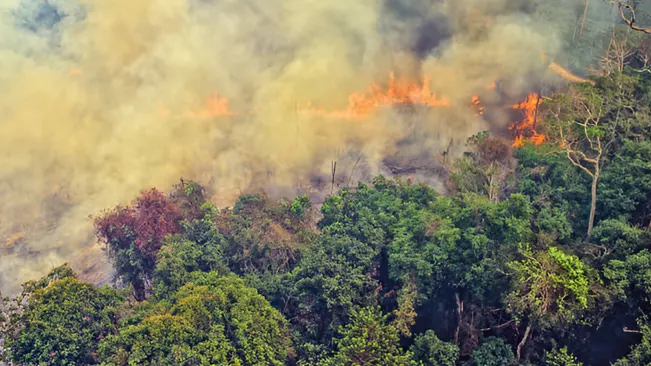
The Basics of Fire Ecology
Fire ecology is a specialized branch of ecology that focuses on the origins of wildland fire and its interactions with both living and nonliving components of ecosystems. Unlike the traditional view that often regards fire solely as a destructive force, fire ecology recognizes it as a natural process that contributes to ecosystem dynamics. To fully grasp the concept of fire ecology, one must consider several critical aspects:
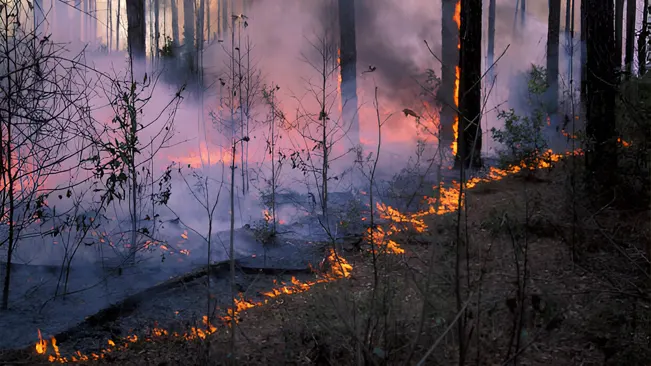
- Ecosystem Dynamics: Understanding an ecosystem requires looking beyond its current state. It involves examining its history, potential future changes, and the cyclical processes that govern its functioning. Fire is one of several natural catalysts alongside floods, storms, and earthquakes that can instigate significant changes within an ecosystem.
- Fire Dependence: This concept emerged in the 1930s when researchers in the southern United States challenged the prevailing negative perceptions of fire. They posited that certain ecosystems, particularly longleaf pine forests, depend on fire for their health and regeneration. Fire dependence refers to plant species that rely on fire to create conditions conducive to their growth. For instance, fire can enhance soil nutrient availability, reduce competition from other plant species, and promote seed germination.
Fire History: Recording the Past
The second key concept in fire ecology is fire history, which examines the frequency and patterns of fire occurrence in specific geographical areas. Trees serve as natural recorders of fire history. Each year, trees add a new layer of growth, creating growth rings. When a fire occurs, it may scorch the tree, leaving behind a layer of charcoal. Over time, this charcoal is covered by new growth, creating a fire scar. Scientists can analyze these fire scars to reconstruct historical fire events, providing valuable insights into the frequency and intensity of past fires. This information is crucial for understanding how ecosystems have adapted to fire over time and how they might respond to future fire events.
Fire Regimes: The Role of Fire in Ecosystems
Fire regimes encompass the frequency, intensity, and fuel consumption patterns of fires within an ecosystem. These characteristics are influenced by factors such as climate, vegetation type, topography, and human activity. Understanding fire regimes is essential for effective land management and conservation, ensuring ecosystems remain resilient and biodiverse.
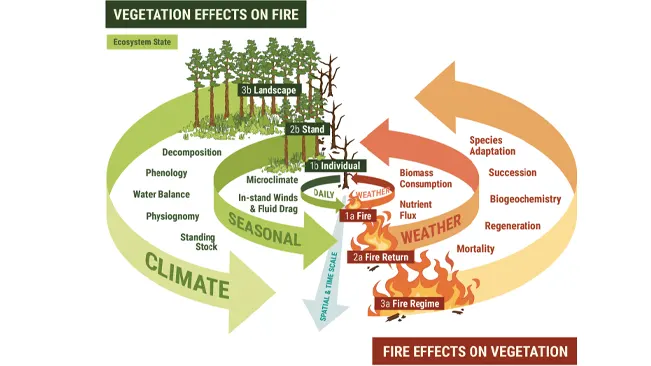
- Frequency of Fire: This is determined by the availability of ignition sources (such as lightning or human activity) and the climatic conditions that favor fire spread. Different ecosystems have varying fire frequencies; for example, some grasslands may experience frequent fires, while certain forests may have longer intervals between fires.
- Fire Intensity: This refers to the heat released during a fire and is influenced by the amount and type of fuel available. The combustion rates of different fuels also play a significant role in determining fire intensity.
- Environmental Influences: Factors such as humidity, wind, and topography interact with fire regimes, affecting how fires behave and spread. For instance, dry conditions and strong winds can lead to more intense and rapidly spreading fires.
Understanding fire regimes is essential for effective land management and conservation strategies. By recognizing the natural fire patterns within ecosystems, land managers can make informed decisions about fire prevention, suppression, and restoration efforts.
The Ecological Benefits of Fire
While fire can be destructive, it also offers essential ecological benefits. It recycles nutrients back into the soil, enhancing fertility for new plant growth. Additionally, fire creates diverse habitats, promoting biodiversity by supporting various species. It also helps control invasive plants, allowing native flora to thrive in their natural ecosystems.
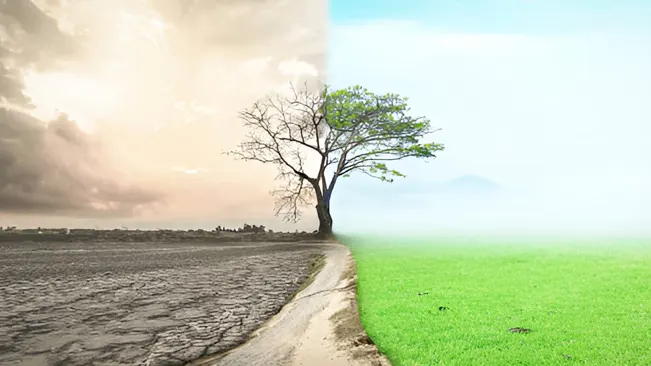
- Nutrient Recycling: Fire helps to recycle nutrients back into the soil. When vegetation burns, it releases nutrients that become available for new plant growth. This nutrient cycling is particularly important in nutrient-poor soils, where fire can enhance soil fertility.
- Habitat Creation: Many species rely on fire to maintain their habitats. For instance, certain birds and mammals thrive in post-fire environments where new growth provides food and shelter. Fire can create a mosaic of different habitats, promoting biodiversity.
- Invasive Species Control: Fire can help control invasive plant species that may outcompete native flora. By reducing the biomass of invasive species, fire can create opportunities for native plants to reestablish and flourish.
Challenges and Misconceptions
Despite the ecological benefits of fire, misconceptions about its role persist. Many people view fire solely as a destructive force, leading to policies that emphasize fire suppression rather than management. This can have detrimental effects on ecosystems that rely on periodic fires for health and regeneration.
Moreover, the increasing frequency and intensity of wildfires in recent years, exacerbated by climate change, have led to heightened concerns about fire management. As ecosystems become more susceptible to extreme fire events, understanding fire ecology becomes even more critical for sustainable land management practices.
Fire Management Strategies
Effective fire management combines strategies to balance fire’s ecological benefits with protecting lives and property. Key approaches include prescribed burns to reduce fuel loads and mimic natural fire regimes, creating firebreaks to slow wildfire spread, and community education to foster understanding of fire’s role in ecosystems and the importance of management practices.

- Prescribed Burns: These are controlled fires set intentionally to reduce fuel loads, promote habitat health, and mimic natural fire regimes. Prescribed burns can help prevent larger, uncontrolled wildfires by reducing the amount of combustible material in an area.
- Firebreaks: Creating firebreaks—strips of land cleared of vegetation—can help slow or stop the spread of wildfires. These are often used in conjunction with other fire management techniques.
- Community Education: Educating communities about the role of fire in ecosystems and the importance of fire management can foster a better understanding of fire’s ecological benefits. This can lead to increased support for prescribed burns and other management practices.
Climate Change Impacts
Incorporate information on how climate change is affecting fire regimes and increasing the frequency and intensity of wildfires. Discuss the challenges this poses for ecosystems and fire management strategies, and explore adaptive management approaches that can help mitigate these effects.
Research and Innovations
Mention ongoing research in fire ecology, including studies on post-fire recovery, the impacts of fire on wildlife, and the use of remote sensing technologies to monitor fire effects. Highlight innovative approaches to fire management that are being developed in response to changing environmental conditions.
Conclusion
Fire ecology is a complex and vital field of study that enhances our understanding of the natural world. By recognizing fire as a natural process that shapes ecosystems, we can better appreciate its role in promoting biodiversity, nutrient cycling, and habitat creation.
As we face the challenges of climate change and increasing wildfire risks, integrating fire ecology principles into land management practices will be essential for fostering resilient ecosystems. Embracing the ecological role of fire can help ensure the health and sustainability of our natural environments for generations to come.
Frequently Asked Questions (FAQs)
- What is fire ecology?
Fire ecology is the study of the role of fire in ecosystems, including its effects on living organisms and the environment. - Why is fire important in ecosystems?
Fire plays a crucial role in nutrient cycling, habitat creation, and maintaining the health of certain ecosystems. It can promote biodiversity and control invasive species. - How do scientists study fire history?
Scientists analyze fire scars in tree rings to reconstruct historical fire events and understand past fire regimes. - What is a fire regime?
A fire regime refers to the patterns of fire occurrence, intensity, and fuel consumption in a particular area, influenced by factors such as frequency, intensity, and environmental conditions. - Are all fires destructive?
No, while fires can be destructive, they also provide ecological benefits. Prescribed burns, for example, are controlled fires used to reduce fuel loads and mimic natural fire regimes. - How do fire-dependent species adapt to fire?
Some species have evolved adaptations to survive or even thrive in fire-prone environments. For instance, some plants have thick bark or serotinous cones that open with heat to release seeds. - What are some challenges in fire management?
Challenges include balancing ecological benefits with the need to protect human life and property, as well as misconceptions about the role of fire in ecosystems. - How does climate change affect fire regimes?
Climate change can lead to more frequent and intense wildfires, altering natural fire regimes and posing challenges for ecosystems and fire management. - What is the role of fire in nutrient cycling?
Fire helps recycle nutrients back into the soil by releasing nutrients from burned vegetation, which can then be used by new plant growth. - How can communities learn about fire ecology?
Community education programs can help foster a better understanding of fire’s ecological role and the importance of fire management practices like prescribed burns.

Evan Bennett
Forestry AuthorEvan Bennett brings over a decade of expertise in forestry wildlife management to the forefront, specializing in habitat conservation, biodiversity, and human-wildlife interaction. Evan's work ensures harmonious coexistence between wildlife and human communities through effective and sustainable practices. Continuously engaging in research and workshops, Evan stays at the cutting edge of wildlife management advancements. As a trusted advisor and contributor to leading environmental journals, Evan is dedicated to preserving the natural world for future generations.

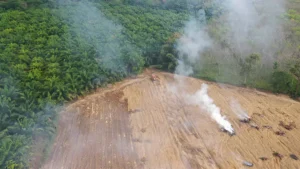



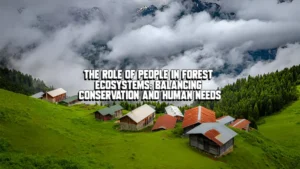
Leave your comment